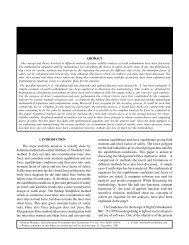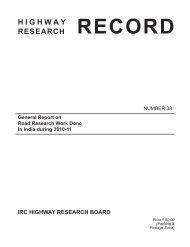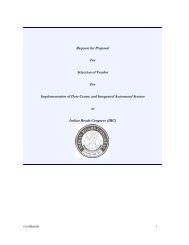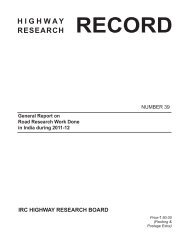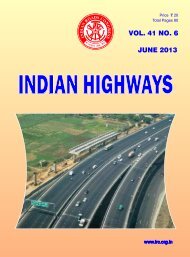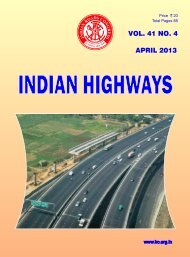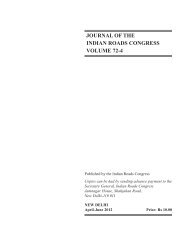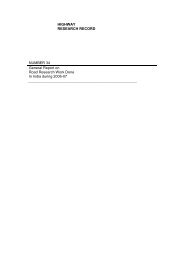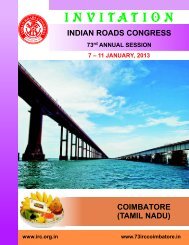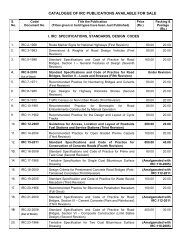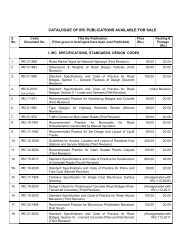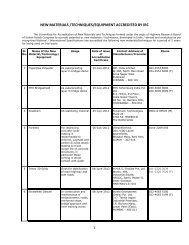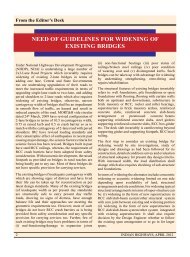A Review of Highway Agencies in the South Asia Region
A Review of Highway Agencies in the South Asia Region
A Review of Highway Agencies in the South Asia Region
Create successful ePaper yourself
Turn your PDF publications into a flip-book with our unique Google optimized e-Paper software.
A <strong>Review</strong> <strong>of</strong> <strong>Highway</strong> <strong>Agencies</strong> <strong>in</strong> <strong>the</strong> <strong>South</strong> <strong>Asia</strong> <strong>Region</strong><br />
quarter <strong>of</strong> total roads <strong>in</strong> Sweden <strong>in</strong> 2008, <strong>the</strong>y were subject to 70 percent <strong>of</strong> road usage.<br />
State roads <strong>in</strong>clude European highways, national roads and o<strong>the</strong>r country roads, all <strong>of</strong> which<br />
are managed by STA.<br />
Quality <strong>of</strong> <strong>the</strong> Network<br />
Of <strong>the</strong> total state road network <strong>in</strong> Sweden, a road length <strong>of</strong> 78,634 km (79.9 percent) is<br />
paved. Most unpaved roads <strong>in</strong> Sweden are found <strong>in</strong> <strong>the</strong> forest counties, and are given<br />
priority for ma<strong>in</strong>tenance.<br />
Road quality <strong>in</strong> Sweden is def<strong>in</strong>ed by w<strong>in</strong>ter road conditions, road surface smoothness, and<br />
friction and bear<strong>in</strong>g capacity restrictions. Roughness is measured quantitatively along a<br />
scale <strong>of</strong> <strong>the</strong> International Roughness Index (IRI) based on vehicle cost and travel speed <strong>of</strong><br />
<strong>the</strong> road <strong>in</strong> question. New roads are assigned an IRI <strong>of</strong> 1, <strong>the</strong> poorest roads a 5. In Sweden,<br />
priority is given to those roads with IRI <strong>of</strong> more than 4. These are primarily found <strong>in</strong> forest<br />
counties with traffic volumes <strong>of</strong> below 2,000 vehicles per day. Rut depth is also measured,<br />
identify<strong>in</strong>g those roads with ruts <strong>of</strong> more than 15 mm.<br />
Government Policy for <strong>the</strong> Road Sector<br />
The M<strong>in</strong>istry <strong>of</strong> Enterprise, Energy and Communications has sole responsibility for national<br />
transport policy. Once policy has been designed, and ref<strong>in</strong>ed to <strong>in</strong>clude stakeholder<br />
feedback, it is <strong>the</strong> task <strong>of</strong> <strong>the</strong> Parliamentary Committee <strong>of</strong> Transport and Communications<br />
to give approval.<br />
At <strong>the</strong> government level, transport policy objectives are set for periods <strong>of</strong> 10 years. SRA<br />
advised and drafted <strong>the</strong> outl<strong>in</strong>es policy objectives, technical standards and performance<br />
<strong>in</strong>dicators as stipulated by <strong>the</strong> Swedish Parliament. It formulated <strong>the</strong> Government’s National<br />
Road Transport Plan for approval by <strong>the</strong> Riksdag (Swedish Parliament). It proposed policy<br />
objectives and actions to achieve <strong>the</strong>se objectives, <strong>in</strong>clud<strong>in</strong>g <strong>the</strong> ma<strong>in</strong> road construction<br />
works for <strong>the</strong> com<strong>in</strong>g years. The Riksdag gave approval for <strong>the</strong> most recent policy plan <strong>in</strong><br />
March 2009.<br />
The focal po<strong>in</strong>ts <strong>of</strong> this plan are:<br />
Accessibility: good quality transport for everyone, gender-equality, and special<br />
attention to <strong>the</strong> disabled and children as transport users; and<br />
Health, Safety and Environment: reduce fatal and serious accidents by 50 percent from<br />
2007 to 2020.<br />
Safety on <strong>the</strong> roads is a major guid<strong>in</strong>g <strong>the</strong>me <strong>in</strong> policy formalization. The Vision Zero project,<br />
started <strong>in</strong> 1997, laid <strong>the</strong> foundation for a strategic approach to road safety policy <strong>in</strong> Sweden.<br />
The global objective is to achieve a road system where no one is at risk <strong>of</strong> fatal or severe<br />
<strong>in</strong>jury. From this foundation, <strong>in</strong>terim goals are formulated at different <strong>in</strong>stitutional levels.<br />
C.3.2 Introduction to <strong>the</strong> Swedish Transport Adm<strong>in</strong>istration<br />
Strategy<br />
The STA has <strong>the</strong> task <strong>of</strong> ensur<strong>in</strong>g a holistic approach to <strong>the</strong> transport system across all<br />
modes. This new approach should also achieve a clearer customer perspective, a stronger<br />
regional base, greater organizational efficiency and support for <strong>in</strong>novation and productivity<br />
<strong>in</strong> <strong>the</strong> construction <strong>in</strong>dustry. The STA has <strong>the</strong> follow<strong>in</strong>g vision, mission and objectives:<br />
138



